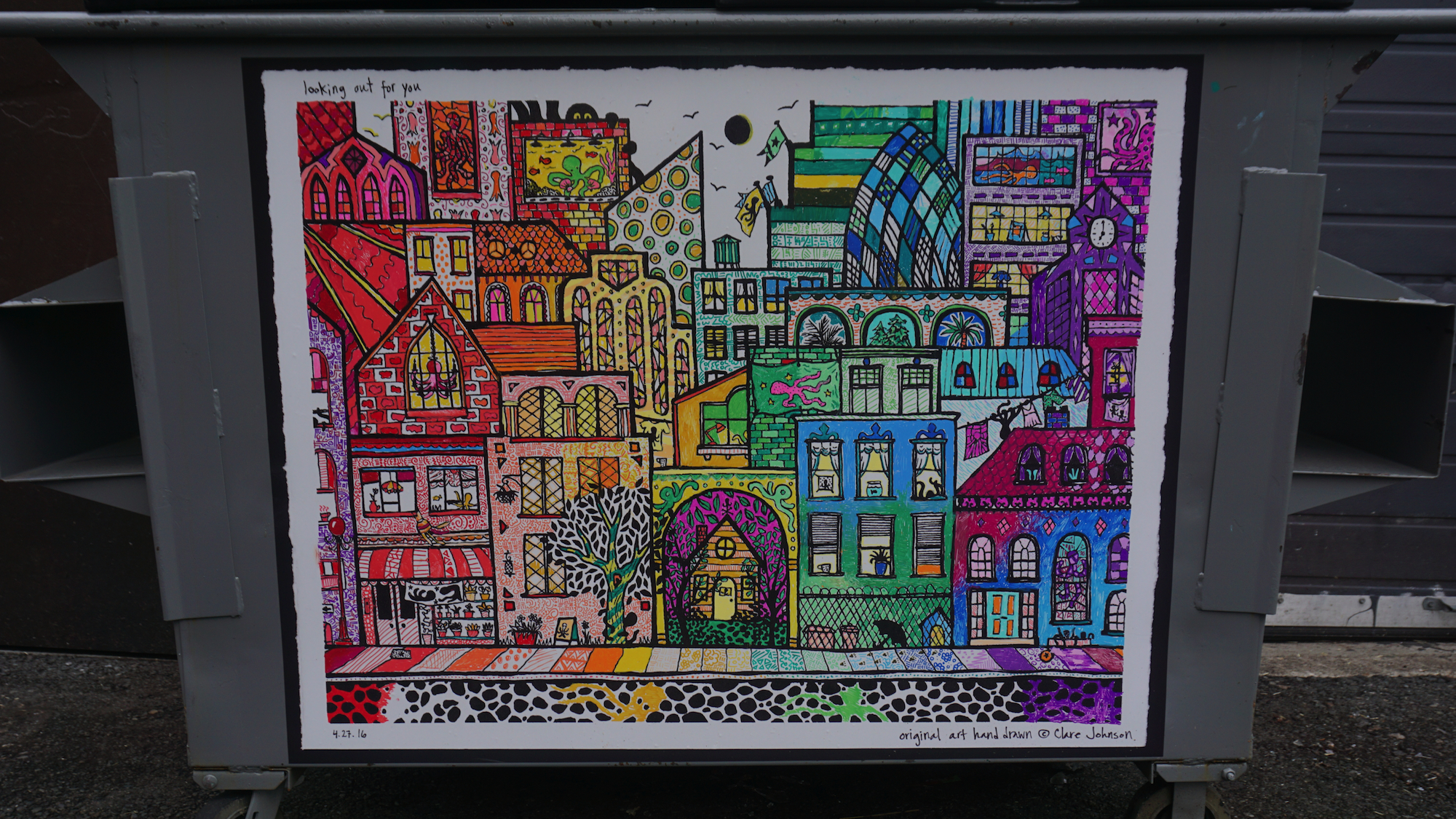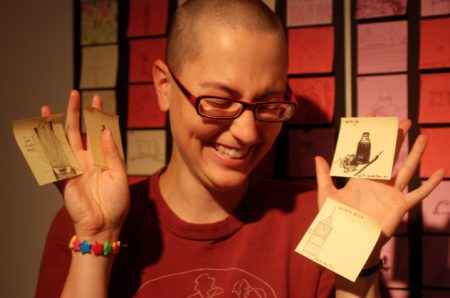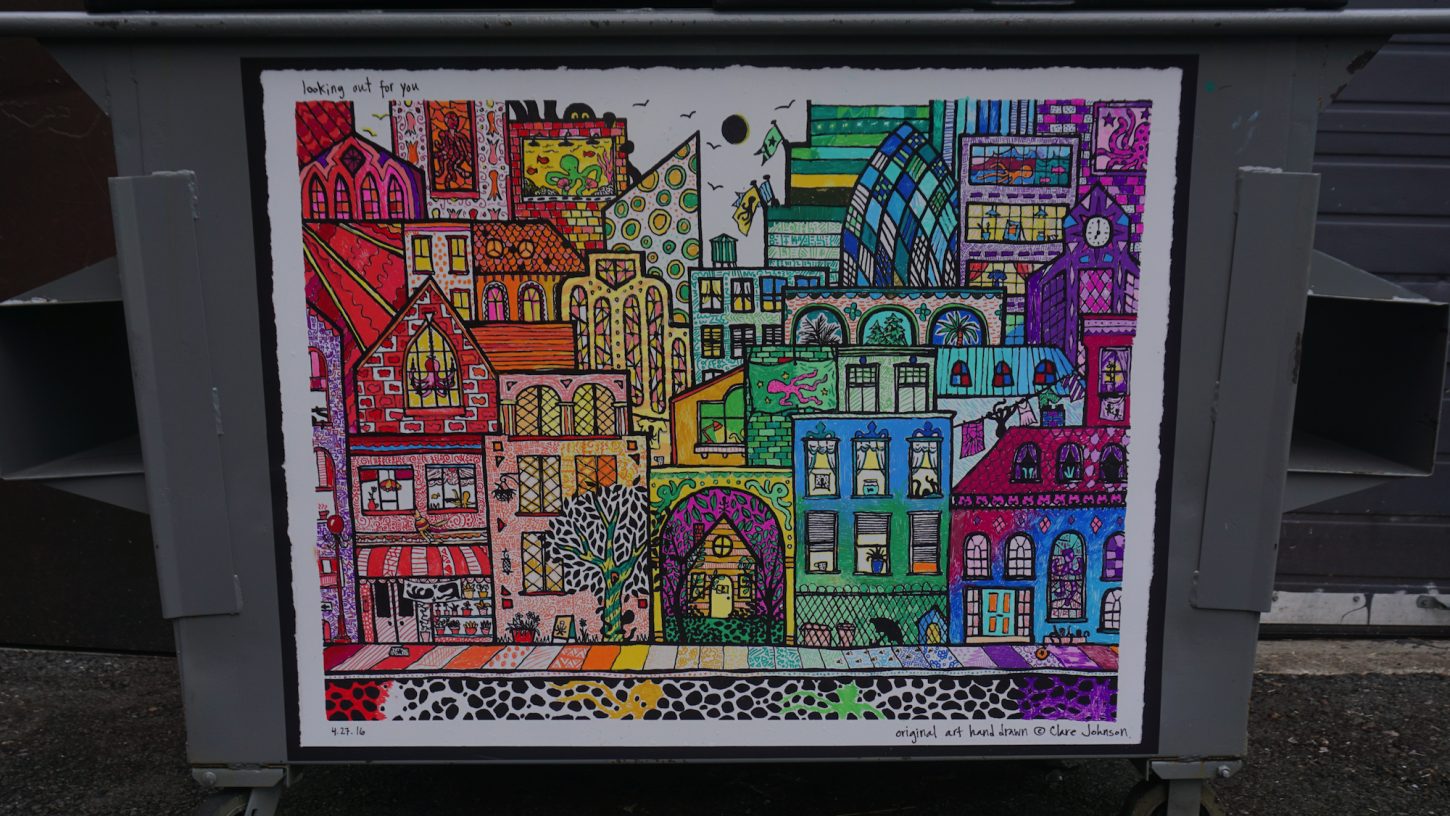Past Resident
Clare Johnson

Clare Johnson is a queer writer and visual artist from Seattle, Washington, making hybrid poetry, intricate dip pen drawings, acrylic paintings of memories, participatory public art, and multidisciplinary projects expanding into theater and book art. Across disciplines, Johnson’s art-making philosophy is inspired by ordinary objects with dual meanings —post-its, ephemeral/disposable yet meant to hold onto something you’ll forget, and band-aids, signaling healing attention or a wound equally. For her ongoing Post-it Note Project, Clare has drawn and written on a post-it every night to save something from each ending day (currently spanning over 10 years and roughly 4,000 post-its). Her work honors what normal communication is unequipped to show — the countless separate times held within each person or place, endlessly overlapping, collapsing, refocusing.
“I love the idea of art celebrating overlooked spaces, turning into a surprise gift for a stranger. I’d like people encountering my work to feel connection — recognizing shared emotions and experiences, feeling more known and understood through that — but at the same time also exercise valuing the unknown, valuing difference, reveling in all our individual ordinary mysteries.”
 Q&A with Clare Johnson (from the Crosstown Arts newsletter, March 19, 2021)
Q&A with Clare Johnson (from the Crosstown Arts newsletter, March 19, 2021)
Crosstown Arts residency alumnus Clare Johnson is a dyke-identified writer/artist originally from Seattle. She’s never had gallery representation but has exhibited in diverse community settings, including Seattle writing center Hugo House, Storefronts Seattle, Lauderdale House’s queer art competition (London), and Guy’s Hospital (London), where her 35-drawing project about childhood asthma is permanently displayed.
Other major projects include a 2017 production of Our Town combining handmade art and erasure poems from Thornton Wilder’s script into gesture-responsive animations on a giant 360-degree screen; her ongoing Post-it Note Project (drawing/writing on a Post-It each night for 12+ years), excerpted online in The Seattle Review of Books with monthly lyric essays; and designing a participatory coloring sheet mural on a dumpster for a neighborhood celebration with a Seattle low-income housing group.
Publications of her work include Poetry Northwest, Shake the Tree, Raven Chronicles, and Roses, a book pairing Rilke poems with her drawings. In addition to a 2020/21 Hugo House writing fellowship, she’s currently engaged in three community projects in Seattle: poster art for regional transit, temporary public art for the AIDS Memorial Pathway in a city park, and a participatory art project to decorate fencing around a Tiny House Village for people transitioning out of homelessness.
Crosstown Arts registrar Jesse Butcher caught up with Clare to discuss her public projects, the artists who inspire her, and how she has adjusted her art practice during the pandemic.
Jesse: You started several intense public projects while in residency at Crosstown Arts. One Memphis-based project involved developing an inaugural publication with the students of Crosstown High. Two other large projects were being developed for Seattle: the Tiny House Village and the AIDS Memorial Pathway. Can you speak on how you traverse through projects involving a variety of communities and issues?
Clare: I like walking everywhere, noticing new details, like an entertaining scavenger hunt that I can do for free, whenever I want, whether or not I can afford whatever else a particular neighborhood might be offering. In this same way, I’ve always loved street art, public art, art interventions — anything where art/writing get to be integrated into daily life, encountered by surprise as part of the landscape of my city, instead of separated from everything else, tucked away in a place you have to pay to see them.
So even though I make intimate handmade pieces, tiny and vulnerable, I’ve always aspired to public projects. I feel the same about teaching; it’s absolutely the best scenario for everyone when you get to work for an organization that pays you to teach, but where the students get to access that benefit for free. I’m always striving for more ways I can afford to make my art or writing accessible to people for free, so it’s a HUGE honor to get to work in all three of these community settings. I’m so grateful to have been trusted with this work, and all three are like my dream jobs, all at once!
This year has definitely been a lot to juggle, with each project frequently pulling focus from the others, but there was no way I was going to say no to any of them. And while facilitating a student arts publication is very different from making art to decorate fencing around a Tiny House Village for people experiencing homelessness, or creating public art inspired by interviews with long-term HIV survivors, they all draw on the same part of me as an artist. It’s the part of me that takes things in — staying open to people, listening, learning about them, trying to be sensitive to what they need, and appreciating everything they’re offering — and then reaching inside myself to figure out how to help support that.
In all three of these projects, that involved being honest about what I didn’t know, what I needed to learn myself, or get help with. I’d already met with the Tiny House Village residents during the fall, so I came to Crosstown Arts with so many amazing ideas and suggestions from them about what they wanted my art to do. Designing and making those twelve drawings was my main studio practice in Memphis: bursts of creative ideas experimenting with how to incorporate everything into each piece, with long stretches of meditative, solitary time listening to music and doing this super-intricate drawing with my hands.
Meanwhile, I was also meeting with Crosstown High students every day — first in person, then via Zoom. Those students were incredible. They’re smart, funny, friendly, thoughtful, full of ideas and questions. I’m an introvert, so while I love teaching, I can often feel inexplicably exhausted afterwards. But working with these students really kept me going and sparked new purpose and energy, especially amidst all the chaos of COVID closures. The places they got to go with their writing and art were inspiring! I really hope people get to see the final product; they worked so hard. So many of them did really close, intensive work on revising their writing pieces. The work is really on track with what I would expect from my adult students. In some ways, my Crosstown High students were actually probably more patient and committed to what they were working on than a lot of adults give themselves permission to be.
Midway through the residency, I started initial research for my AIDS Memorial Pathway project, and I think that was the hardest for me to manage. I had a really difficult time handling being immersed in that history, which strikes really close to home for me personally, especially during this new pandemic. I found myself struggling emotionally in a way I wasn’t really prepared for and didn’t feel like I had time for either. The pandemic really threw off a lot of the logistics of all of these projects, too, since the public art projects were meant to have participatory elements (like community coloring parties to color in the fence art and build neighborhood connections with the Tiny House Village) that now have to be rethought, scrapped, or put on hold. Those are the moments when it’s been a relief to just be open and tell people, like my project manager for the AIDS memorial art, that I need support. There are so many great people behind each of these projects.
Jesse: Who are the visual artists or writers that you have found the most inspiring and/or eye-opening, and how has that list changed over the years?
Clare: I always find this question strangely stressful. I think it reminds me of being put on the spot by art professors in an academic way when I just want to gush about what a fan I am of people. I worry about omissions. I know later I’ll think of countless amazing artists I didn’t mention. I often get most inspired by art forms that I don’t work in myself — in particular I’m a huge fan of music, movies, and dance.
I think about movement a lot and relationships between moving forces, so it’s funny that I make things that are actually static. Right before I came to Memphis, I’d just gotten fairly obsessed with FKA Twigs’ album “Magdalene,” and earlier last fall I’d been really impressed by the movie Portrait of a Lady on Fire. In Seattle, I volunteer at the ballet to be able to see dance performances on an artist’s budget (i.e. for free), and the works I want to see over and over again are mostly by Alejandro Cerrudo, Crystal Pite, and William Forsythe.
Many of the visual artists whose work impacts me the most are also really different from my own. I am constantly impressed by Kara Walker. Félix González-Torres’ candy works blow me away, over and over again; I don’t think I would ever tire of experiencing his work. It knocks something out of me, thinking about who we have lost to AIDS, imagining what else people might have gone on to make and do, wondering how different the world could be.
When I was a teenager and first thinking more seriously about writing, my favorite books were The Bone People by Keri Hulme, and Toni Morrison’s Beloved. I always really liked writers pulling language apart and rebuilding it to mean more things at once, expose things that can’t usually be communicated. But at the same time, Walter Mosley’s fiction, which is more straightforward in its storytelling methods, remains a favorite year after year. He’s so smart. The layers each book juggles are so heavy, but he makes it look easy. My first year living in England, I picked up an unbelievably cheap copy of Nights at the Circus by Angela Carter, and its weirdness still dazzles me. In Memphis, I read In The Dream House by Carmen Maria Machado, which I cannot praise highly enough. While I’m often categorized as a poet, I’m embarrassingly terrible at keeping up with poetry, but both of Laura Da’s books, Tributaries and Instruments of the True Measure, should be essential reading for everyone in this country.
I always wanted to be an artist since before I could remember. But the first time I actually learned about art in school wasn’t until fifth grade, when local artist Rob Wallace came in periodically to work with us. We were just doing projects with crayons, but he showed us a copy he’d painted of Vermeer’s “Girl with a Pearl Earring,” and I felt this sincere connection with something about the way it pauses, the way paint can kind of pause, brushstrokes behaving as if something’s still moving even when it’s not. I was perhaps a very over-serious fifth grader and also so starved for art time in school. Working with Rob gave me something I needed so badly back then. He taught us about Van Gogh, and I decided Van Gogh was my favorite artist for a long time.
As a teenager, I responded to the sort of delicate horror of Egon Schiele’s watercolor sketches and photographs by Diane Arbus. I guess I always find things that give me mixed feelings to be powerful. I learned about Jacob Lawrence a lot in school, because he lived in Seattle then, but I came back to him in a new way when I finally got to see his “Migration Series” as an adult. In person, it really stunned me. I don’t really give things up. I tend to continue loving all things I loved before, but I’m not necessarily always thinking about them in my practice. More fundamental to me is the experience I got from Rob’s teaching. I didn’t necessarily understand I was gay yet, but there was something about that art class time with him where I felt safe and like I belonged, in a way that I didn’t usually. He died of AIDS-related complications a couple years later. I never got to thank him as a grown-up. As part of my AIDS Memorial project, I finally found a way to figure out who he was. I didn’t even know how to unearth his last name until this spring, but now I’ve been talking with his ex-wife and learning so much about him. He never became a famous artist, but I’ve been feeling very inspired lately just by how much he seemed to make all these pieces of his life so artful and how much he was always making out of everything regardless of who was seeing it.
Jesse: Artists are adapting varying modes of creation under the current conditions. Given the necessary pause in your public programming, how have you acclimatized your practice? Have you set up a home studio? Are you writing more? Has this been a period of more reflection than production?
Clare: Being at my Crosstown Arts residency during the initial lockdowns was actually a huge help, because despite all the anxiety and confusion, it meant I still had easy access to a studio and could continue working every day. During my months in Memphis, I managed to complete all 12 drawings for the Tiny House Project in addition to the publication project with Crosstown High, all while my studio building in Seattle was basically shut down. By the time I got home, they’d found safe ways to reopen, but it’s still complicated because I split my studio with someone else, and these days it’s not safe for us to work in the room at the same time. So neither of us have as much access as usual, which does slow everything down. I’ve got a small drawing desk at home for individual pieces, but for these bigger multi-piece projects, I’ve had to spread tons of planning materials, research notes, interview quotes, image mock-ups, and test samples out all over the studio.
The community participation aspect of the Tiny House Village project is so important. The village helps so many people transition into housing, and the residents talk about how life-changing the community and stability there have been for them. It’s been a really successful part of the neighborhood, and the city of Seattle mostly supports them, but there are definitely still stereotypes and fears and people who don’t understand the positive force of these spaces. A big goal of how we designed this project was neighborhood coloring parties to bring lots of people together in a fun, low-pressure way that would celebrate the village and spark new positive connections around it. Gathering a big group to share paint pens and color in the art banners absolutely cannot happen right now; it’ll be a long time before it’s really safe, but I’m also not willing to totally let go of that community benefit yet. For now, we’re installing the banners of my black-and-white drawings but holding off indefinitely on the participatory part. If things drag on too long, I may have to rethink and strategize new plans for coloring, but I’m hoping eventually we’ll be able to go back to the original plan.
On the other hand, the AIDS Memorial Pathway project is funded by the city and has a much more formal structure, with a firmer timeline and a project manager. For that one, I had to go back and just build the project in a completely different way that would be safe during the pandemic. I interviewed long-term survivors via Zoom and wove their experiences and stories into the art designs, which I will then color in myself. It’s been a huge amount of planning and problem-solving and testing and also a ton of math, because the handmade art I make will get enlarged as vinyl wraps filling 14 window alcoves on a building. I am really looking forward to the part where I’m finally just drawing and coloring!
It’s funny you ask about writing more, because I just started a year-long writing fellowship at Hugo House in Seattle, with an incredible cohort of writers. Getting to know them has been this joyful surprise of new friendships and creative support amidst this time of distancing — an unexpected, totally delightful privilege. I’m really excited for what’s ahead with everybody’s writing! But I’ll admit that personally I’m having a hard time writing right now. I’ve managed to keep going with those big art projects, but like a lot of people I’m also really struggling with focus and energy.
Drawing is a really comforting activity for me, but my writing is kind of the opposite. It tends to stir things up. I love being able to write. I need to express certain things that way, but the actual process unsettles me emotionally in a way I’m not sure I can handle right now. I’m trying though. It really helps to be connected with these other writers, who are all grappling with the world right now in such smart, kind, thoughtful, and tough ways. I’m grateful for just learning how to be there for each other, help each other keep going with our work, but also be validating about the ways in which it’s just hard right now. It’s great that some people out there are having huge creative bursts, but it’s also really okay to admit that there’s a ton of trauma to deal with. Sometimes making your art helps with that, and sometimes you just need a break to take care of yourself, take care of your friends, your community, and each other.
Thank you, Clare! It has been great to learn more about your practice!

